Tragon A. Mcfall, Diane Smith, Dr. Julia Oxford

Abstract
The Biomedical Research Center (BRC) at Boise State University (BSU) is a core facility focused on the study of biomolecules with emphasis on proteins and their molecular interactions. Since establishment in 2001, the BRC has been the administrative center for multiple programmatic and individual researcher-initiated biomedical research grant awards. These awards have made a significant impact on research and research infrastructure growth. Our research focused on co-authorship networks of the National Institutes of Health (NIH) Biomedical Research Infrastructure Network (BRIN), Idaho Institutional Development Award (IDeA) Network of Biomedical Research (INBRE), and the Center of Biomedical Research Excellence (COBRE) in Matrix Biology programs. These programs have established critical infrastructure, funding, leadership, and mentorship to support biomedical/biomolecular research throughout the state. Here we are utilizing VOSviewer to visualize combined bibliometrics of these programs, gaining insight into the breadth and depth of impact that these programs have on research in Idaho.
Methods
Details of articles published under P20GM109095, P20GM103408, and P20RR016454 from 2001 to 2019 were accumulated using NIH Reporter and converted into MEDLINE text format. Bibliometric information was imported onto Vosviewer to generate the networks. Author duplications were accounted for using a thesaurus of author names, which identified author pseudonyms and assigned them a singular name.
The networks were organized according to authors associative strength, which normalizes the network according to the strength of links between items. This results in clusters of authors who have co-authored more publications. This typically represents research groups within universities.
Associative strength network calculates the associated strength between nodes using similarity measure, which is a probabilistic affinity. This probabilistic affinity indicates how alike two or more nodes are by determining the strength of their association. The strength of their association is measured using a probabilistic affinity index, also referred to as proximity index, which measures the similarity _ between objects i and j with the equation:
s_ij= c_ij/(w_iw_j)
where c_ij indicates the number of co-occurrences between items i and j, and w_i and w_j indicate the total number of occurrences of these items.
Results
Key:
- Node size: magnitude of co-occurrences
- Node color: median year of co-occurrences
- Edges: magnitude of co-occurrence instance
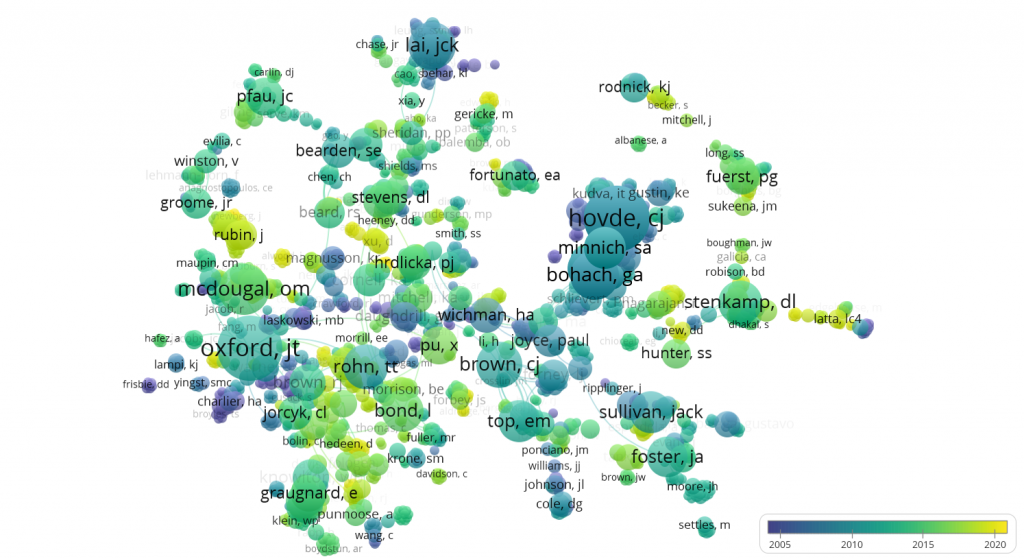
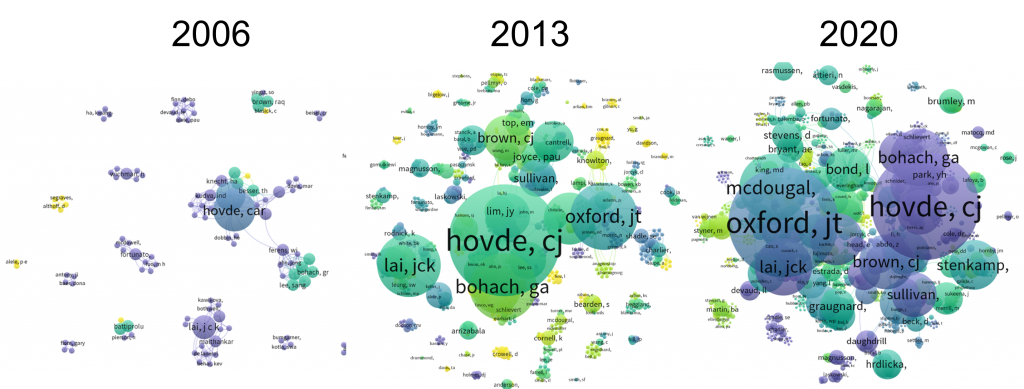
Additional Information of Interest
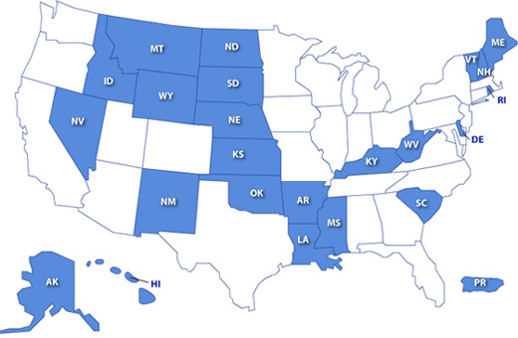
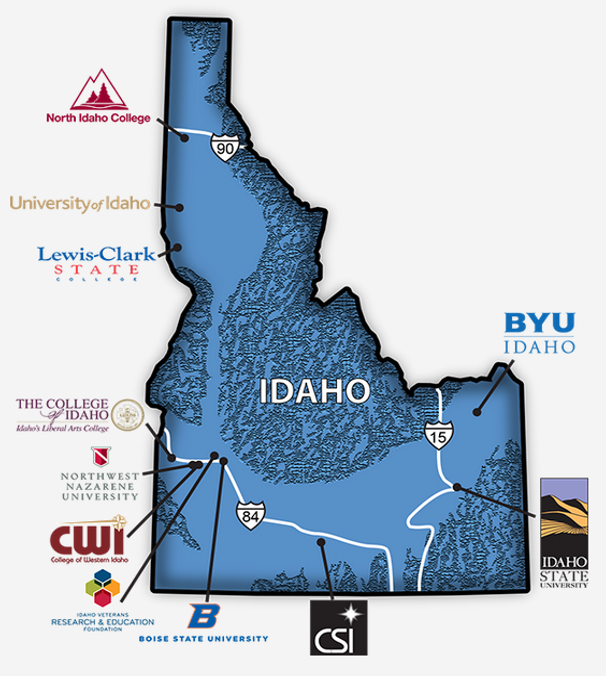
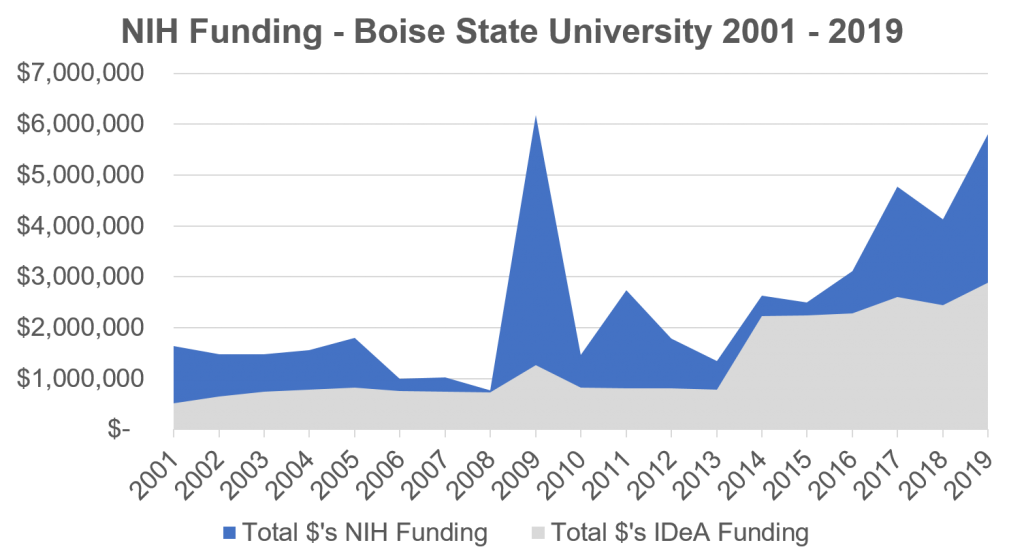
Discussion
BRIN, INBRE and COBRE in Matrix Biology investments to support related infrastructure and research in Idaho has resulted in a noteworthy amount of peer-reviewed published research. Boise State has seen ever-increasing output of research and involvement within these programs since first becoming involved.
Total funding for the three awards analyzed:
- BRIN 2001 – 2011 $24,104,528
- Idaho INBRE 2012 – 2019 $26,685,301
- COBRE in Matrix Biology 2014 – 2019 $12,385,244
- Total $63,175,073
BRC at Boise State accounts for the majority of publications within COBRE and INBRE programs since 2010, growing significantly since the early 2000s. In 2019, Boise State was cited in approximately 90% of instances of inter-university co-authorship under COBRE and INBRE. BRC at Boise State has grown significantly.
Bibliometric mapping could also provide insight on interfaces between domains of science, or interaction of researchers between universities. Potential collaborative partnerships could also be identified through examination of interconnectivity of nodes. Information gleaned from bibliometric analysis of BRIN, INBRE, and COBRE could be utilized on grant proposals as it characterizes the current and potential collaborations in institutional biomedical research programs.
Future
The impact of the ongoing Idaho INBRE and COBRE In Matrix Biology Programs is difficult to measure. Co-authorship analysis is a small part of a much larger story. These programs support research projects, workforce training and development, training, student research experiences, expansion of infrastructure, networking, access to resources, student program development, collaboration and mentorship opportunities, and so much more.
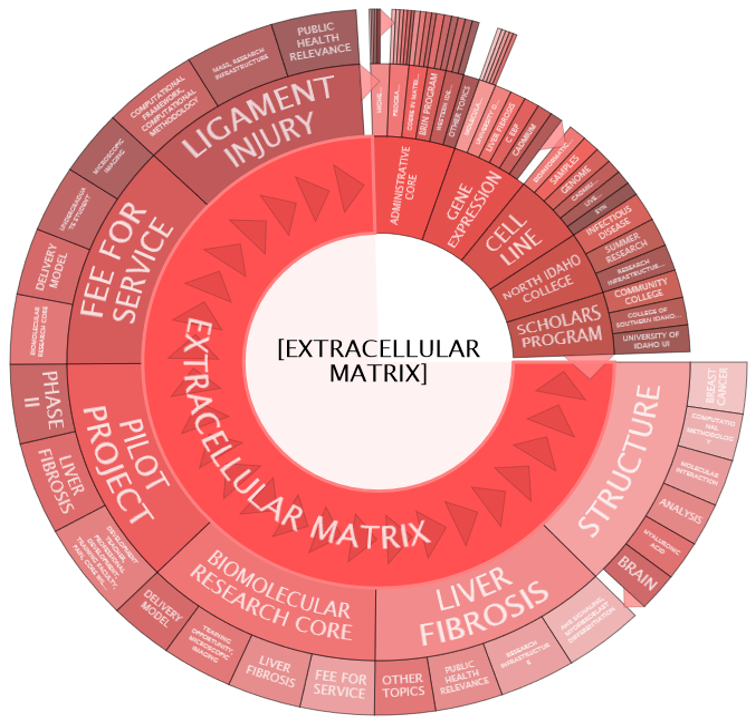
Acknowledgements
Research presented in this poster was supported by Institutional Development Awards (IDeA) from the National Institute of General Medical Sciences of the National Institutes of Health under Grants #P20GM103408 and P20GM109095. The Biomolecular Research Center is supported by funding from the National Science Foundation, Grants #0619793 and #0923535, the M. J. Murdock Charitable Trust; Lori and Duane Stueckle, and the Idaho State Board of Education.
Additional Information
For questions or comments about this research, contact Tragon McFall at tragonmcfall@u.boisestate.edu.